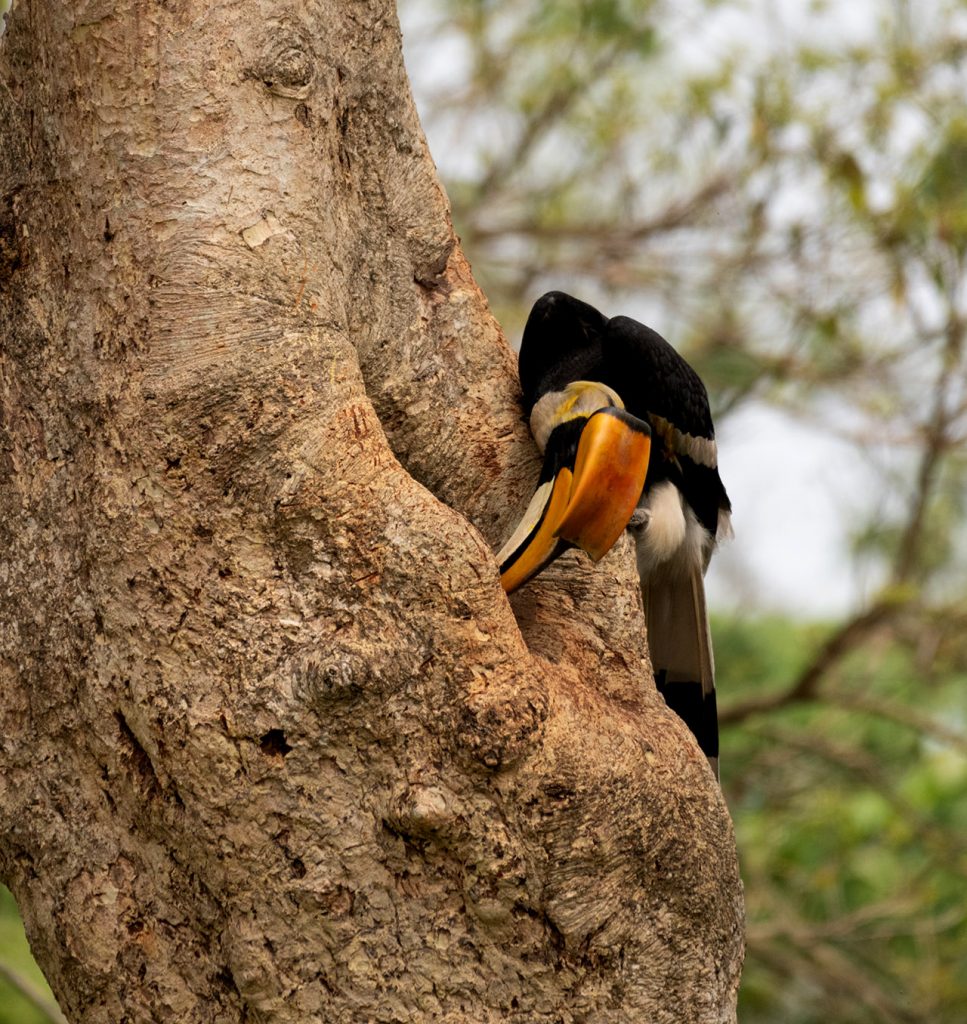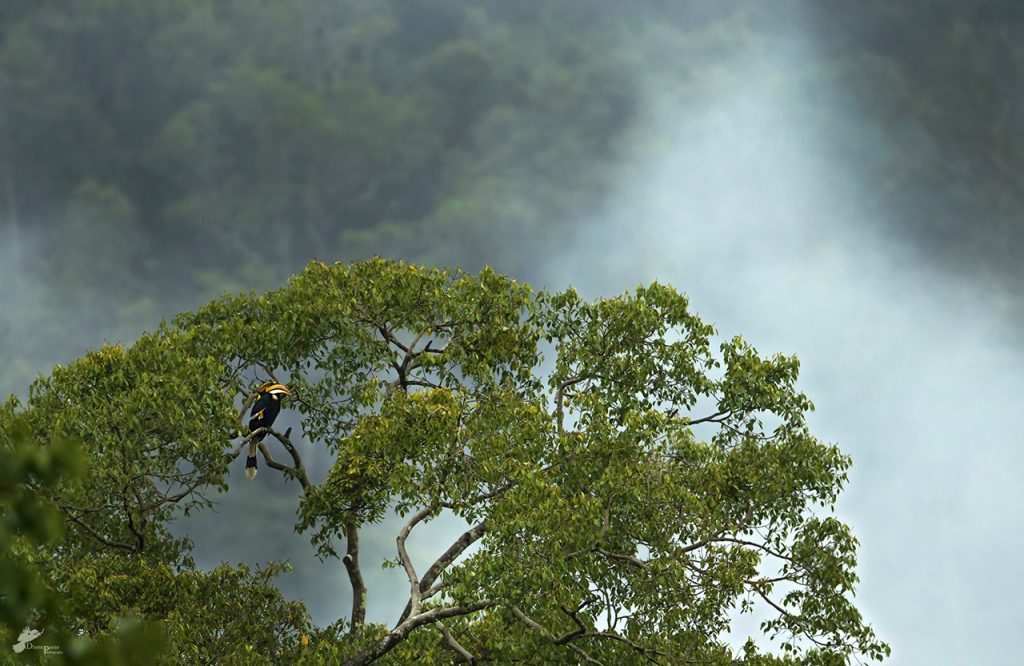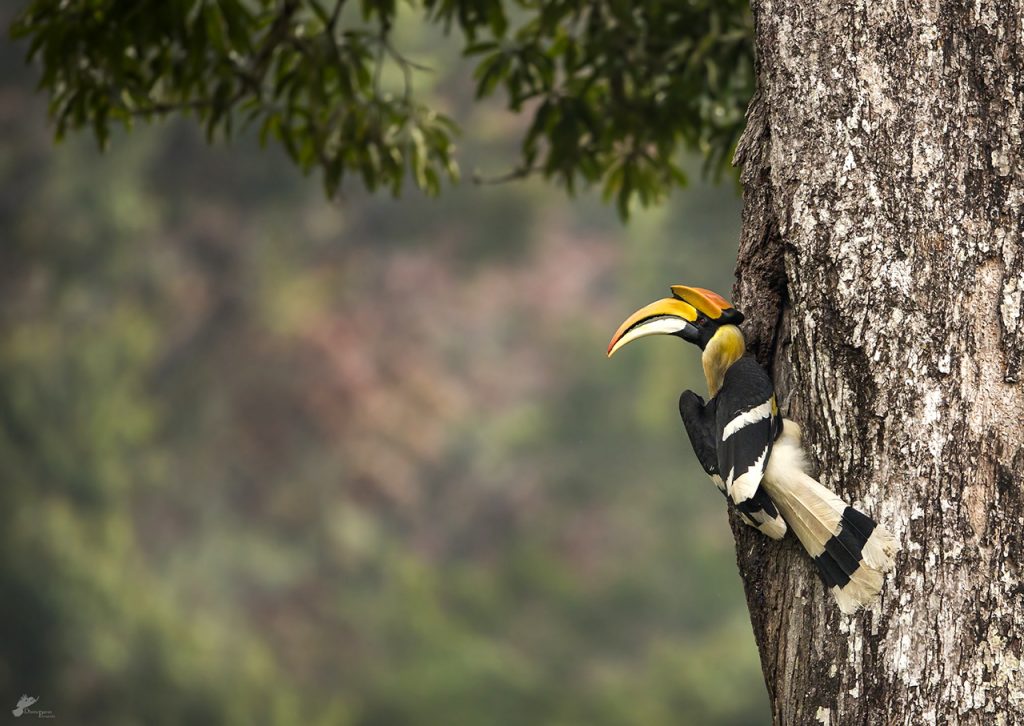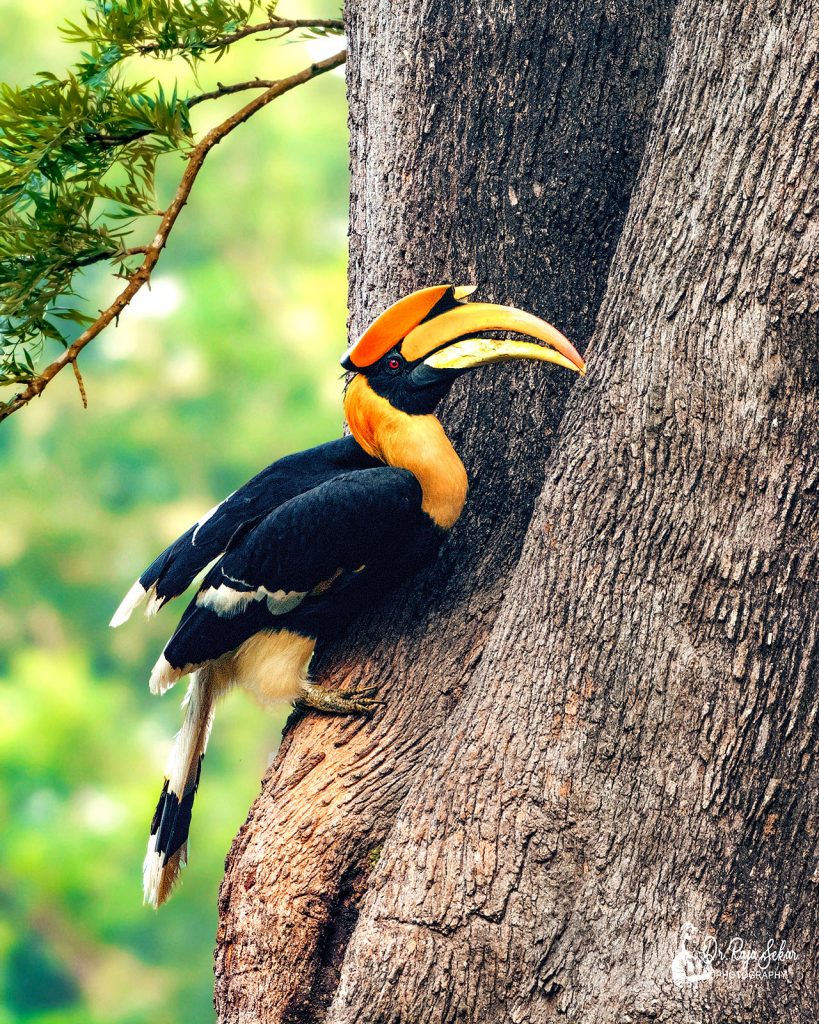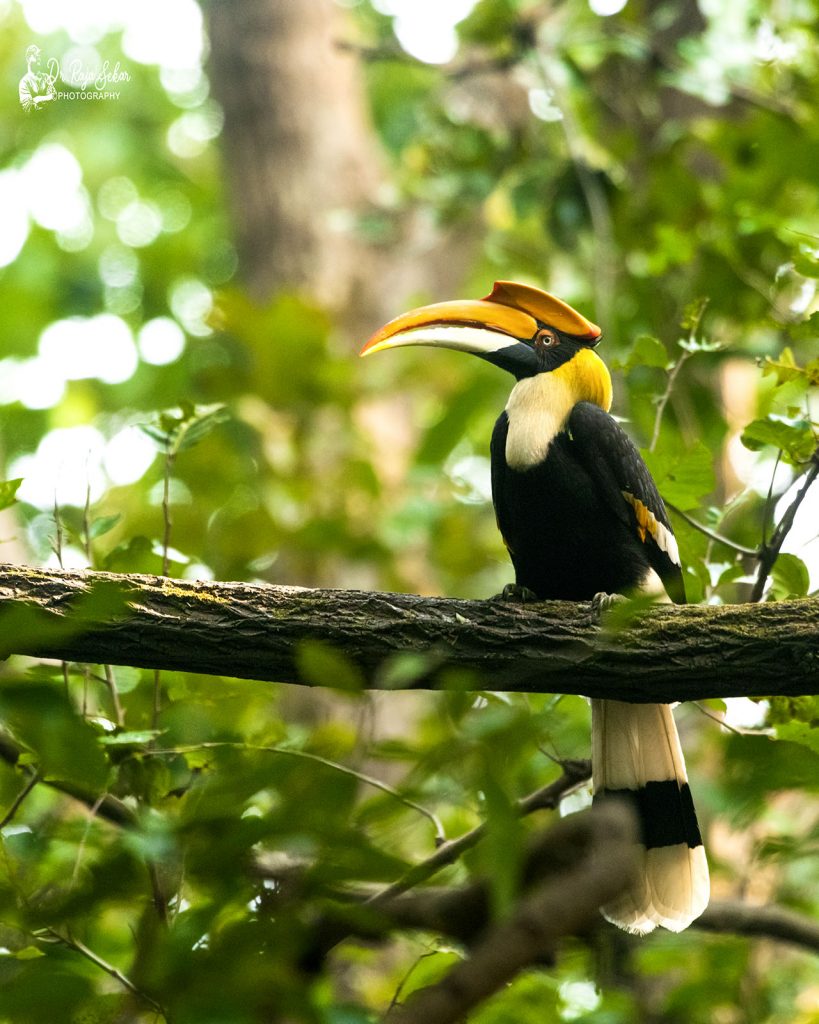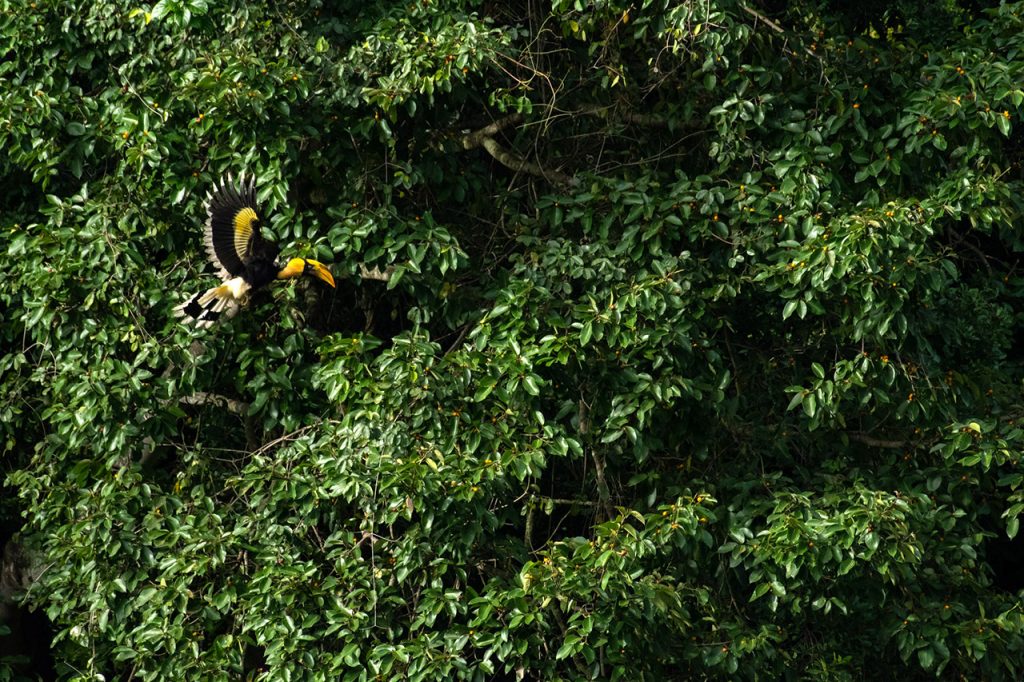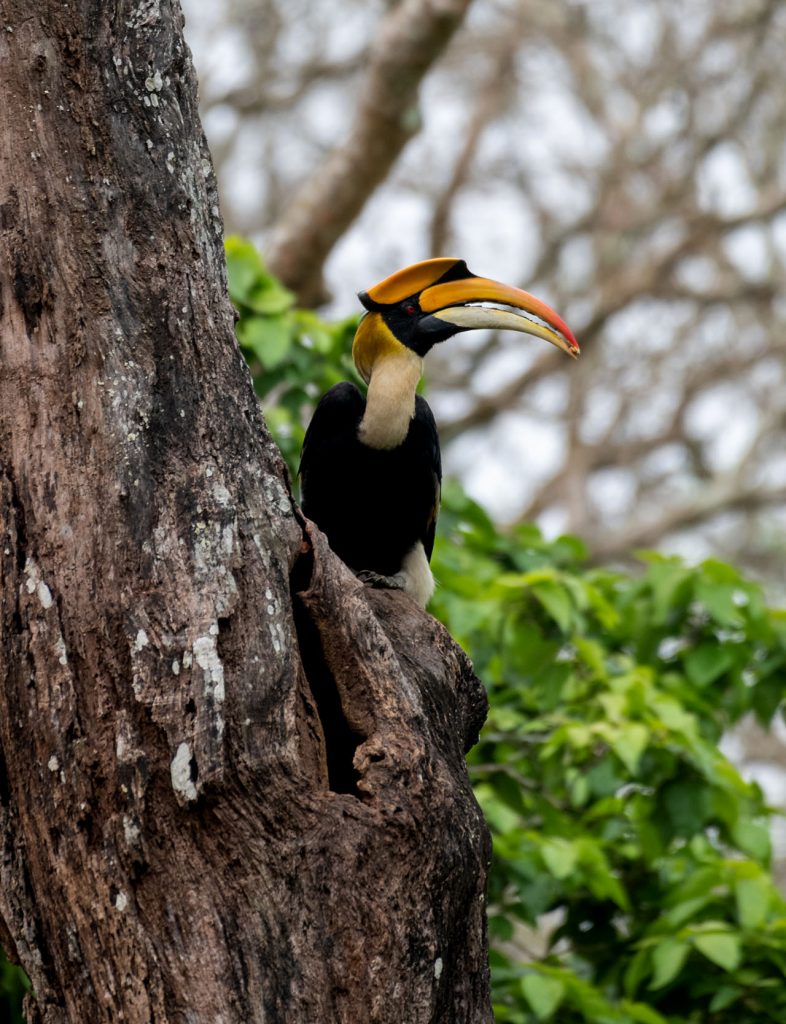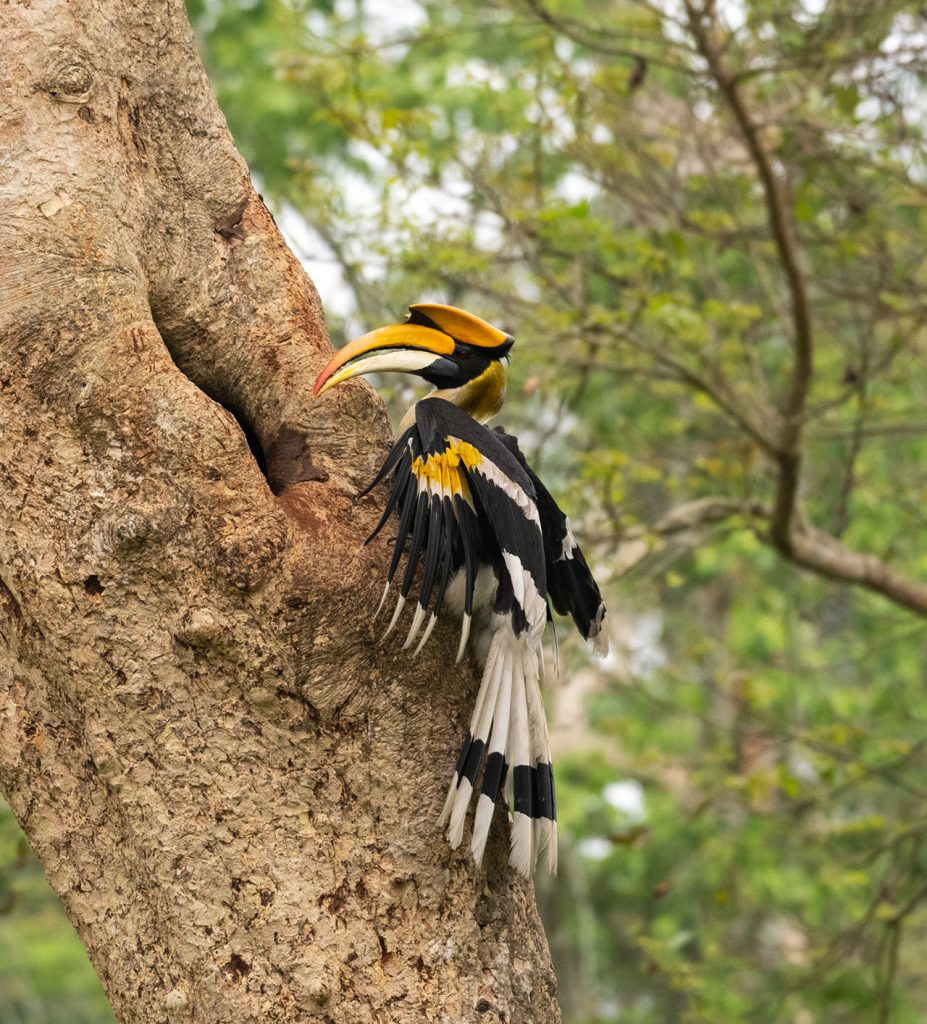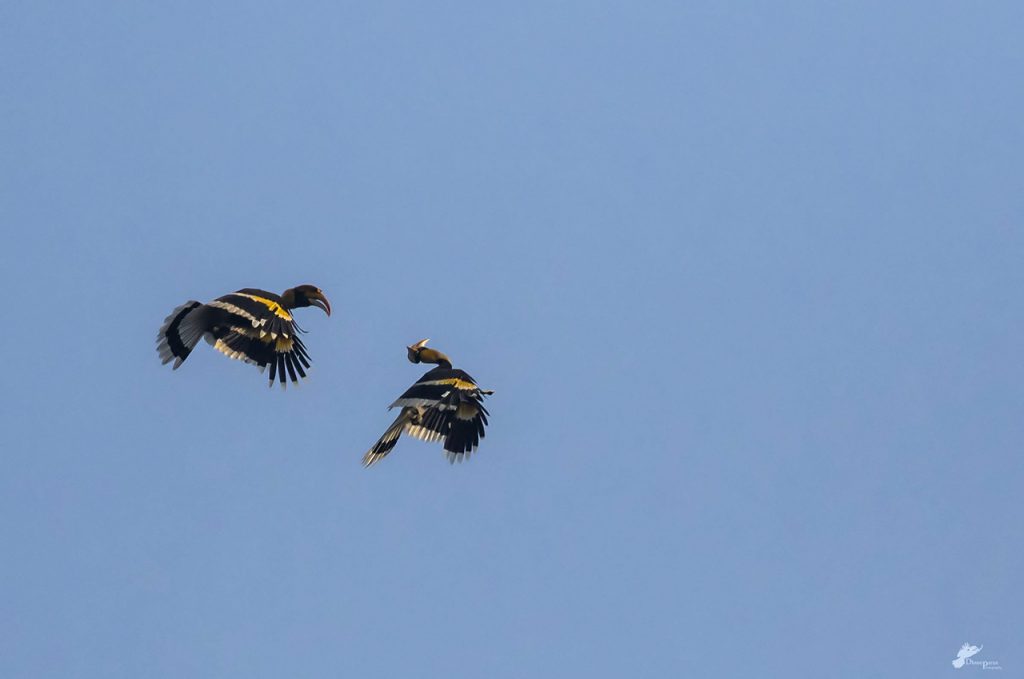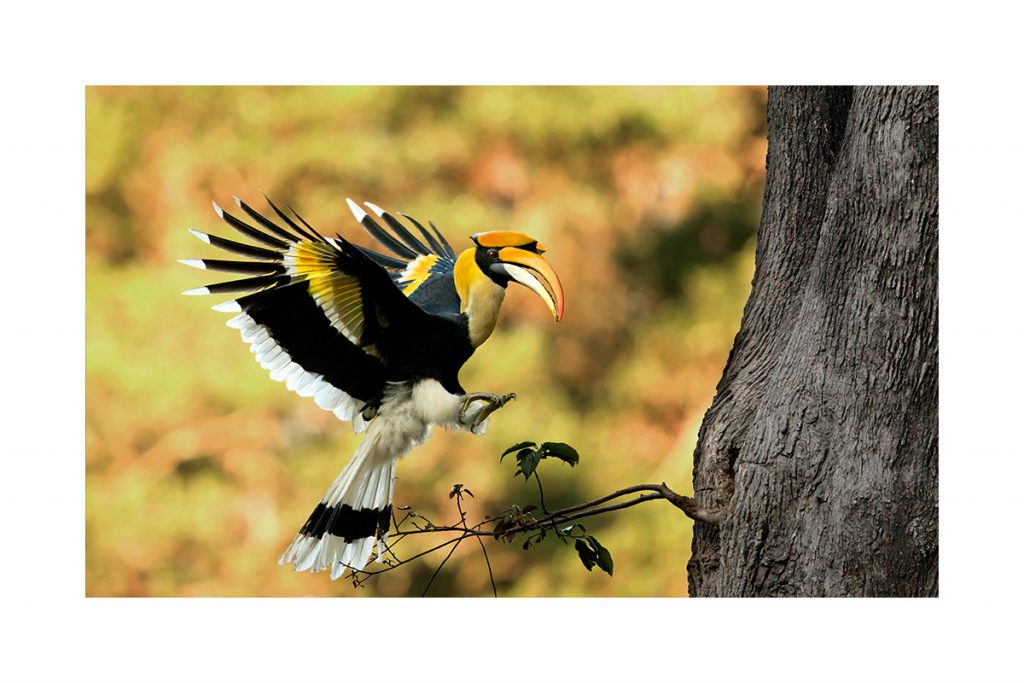Whatever way you look at it, hornbills are truly remarkable birds; remarkable biology, intriguing to watch and with their huge colourfull bills, beautiful birds to photograph. The king of them all is the great hornbill (Buceros bicornis), also known as the great Indian hornbill and the great pied hornbill that is found in extensive stands of natural forest across the Indian subcontinent and southeast Asia.
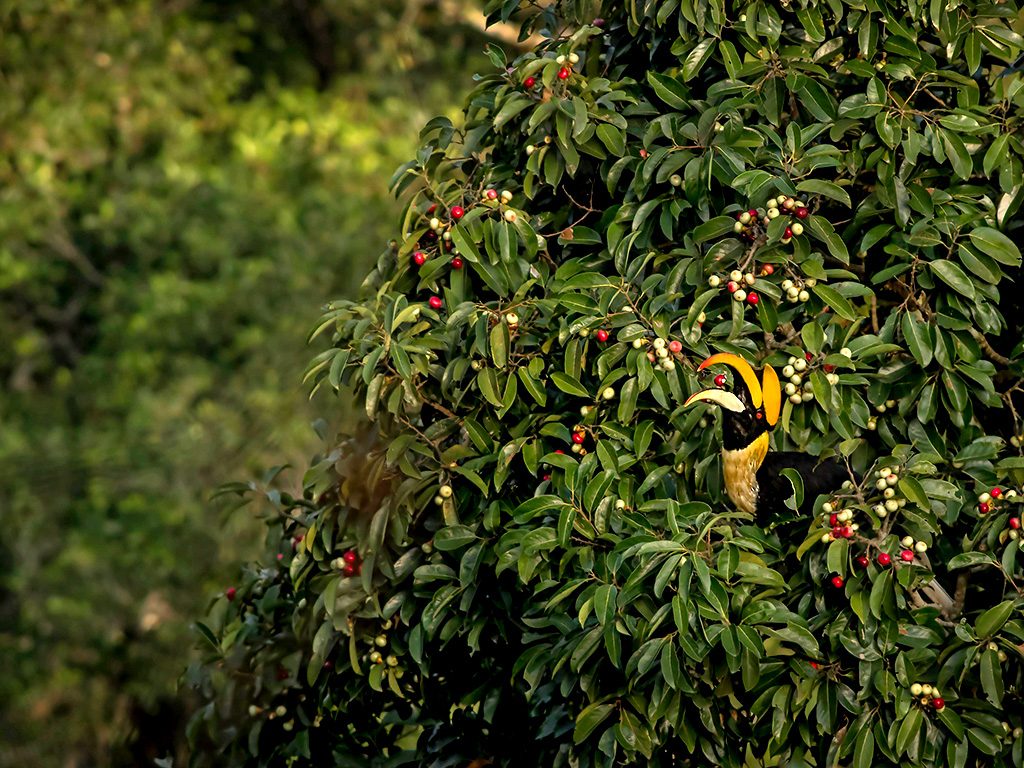
That incredible bill
The hornbill’s plumage is simple black and white, but the bill is huge and topped with a bright yellow and black growth known as the casque. The casque appears U-shaped when viewed from the front and has two ridges along the sides that form points in the front making it one of the most striking birds in the evergreen forests of Asia. The females do not have the black horns on the front and the underneath is reddish, while in the males, the underside of the casque is black. Males also have these distinctive red eyes while the females are white. The casque develops as a hollow structure with a small opening into the mouth and it can act as a resonating chamber when the bird produces its characteristic “kock kock” barking calls. The bright yellow color on both the bill and on the feathers is not a natural feather color but arises when the bird spreads yellow preen oil, that it collects from its preen gland at the top of the tail.

The female locks herself up during nesting
I always find the breeding of hornbills the most amazing part of their biology since after copulation, the female hornbill enters her nesting hole and then using faeces and the remains of food fills in the entrance, so she is totally incarcerated inside the nest hole for the next 100 days. She leaves a narrow vertical slit, through which the male passes her food to feed herself and the chicks. She sits throughout the long ordeal with one eye on the slit, presumably watching for the male to come and feed her, and when she hears him calling, taps on the side of the trunk with her beak. As she settles down into her nest, she goes into moult and loses all her flight feathers, so if the male is killed and she can break out of the nest she will still die because she cannot fly.
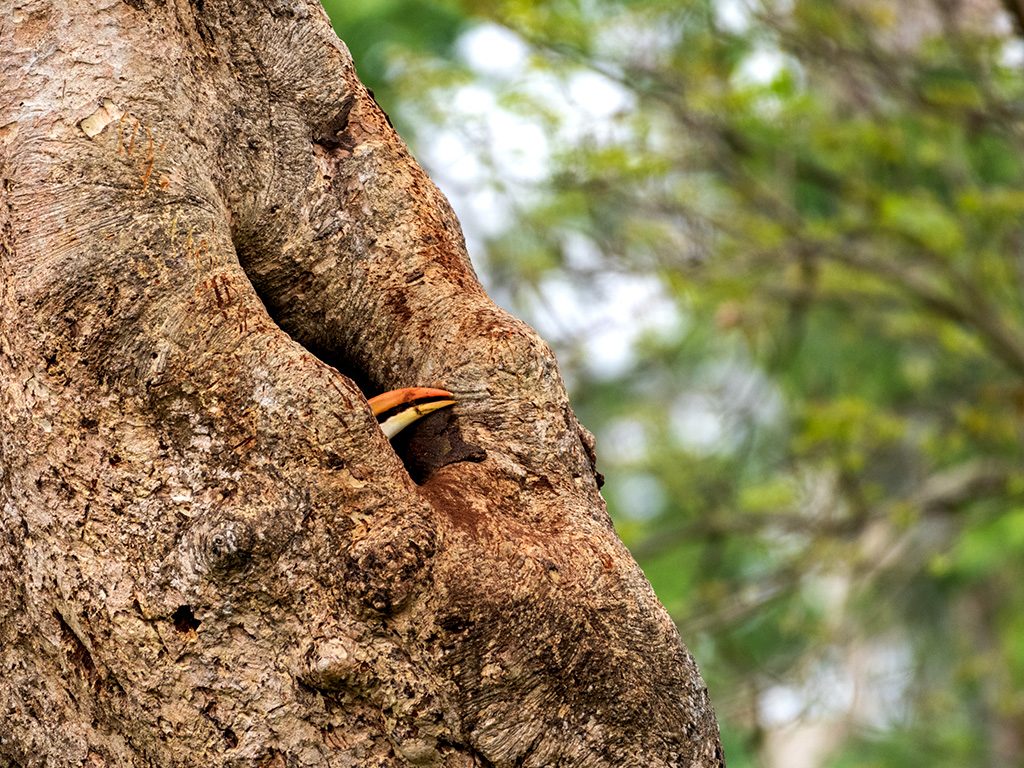
One of the issues with any incarceration is where to poop and she and the chicks get proficient at squirting their droppings through the same narrow slit that they get fed through. They obviously prefer sites that have a natural slit and the vertical shape of the slit is thought to help the movement of fresh air in and stale air out of the nesting chamber. I find it interesting that she doesn’t start laying before quarantining, but enters the nest after copulation and then starts laying the first egg four days later and the next one four days after that. This means she must retain the sperm of the male to fertilize the eggs as they are passed down the oviduct.

The chicks get more than fruit while they are in the nest and the male will bring snakes, lizards and the nestlings of other birds to feed the young, all taken by the female through the slit and carefully processed. She stays in the nest for up to 100 days, releasing herself when the chicks are almost half grown. The oldest chick then seals the nest entrance once the mother has left and then when that chick fledges, the remaining chick once again seals the entrance using their own droppings and food remains until they are ready to fledge. Fascinating bird biology.
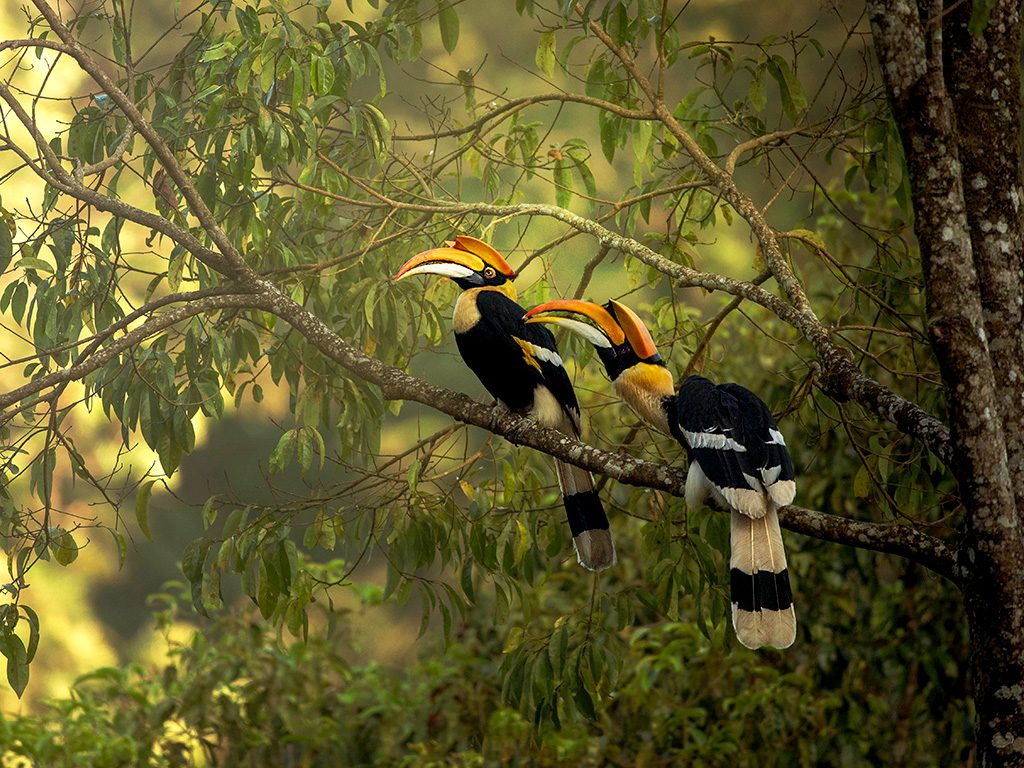
I suspect the primary reason for this breeding behavior is to reduce the likelihood of nest predation. While I have failed to find any observations of hornbills fighting off predators I suspect that when the female is defending from the inside with that big bill and the male attacking from the outside, it would have to be a persistent and brave predator to break down these defenses.
Obviously the selection of the nest sites is important and the pair will visit many holes and cavities before deciding on the preferred site and then, if this turns out to be a good successful site, they will use this same site year after year. They are not highly territorial, but they do defend the area close to the nest site since a safe nest site is an important resource.

One can only marvel at the total dependence of the female and the chicks on the male during the whole nesting cycle. This requires a very tight and trusting bond and so it is not surprising that the male and female hornbills stay together for life – and hornbills can live for up to 50 years. Outside the breeding season, they spend all their time together and when moving through the forest, call continuously to each other in a synchronized manner – known as antiphonic calling. If you are a female and going to lock yourself up for a 100 days and be totally dependent on your mate, then you must know he is not going to abscond, he is good at foraging and will keep you well fed during your incarceration.

Conservation status
The great hornbill is currently listed by the IUCN red list as Vulnerable with roughly 20,000 individuals remaining and the population decreasing. The bulk of the population is found in India, throughout the foothills of the Himalayas and down through Myanmar, Thailand, Cambodia, Vietnam, Laos across the Malaysian peninsula and onto Sumatra. A second, unconnected population exists in the wet evergreen forests of western India along the Western Ghats, usually in protected forests (Figure 1).
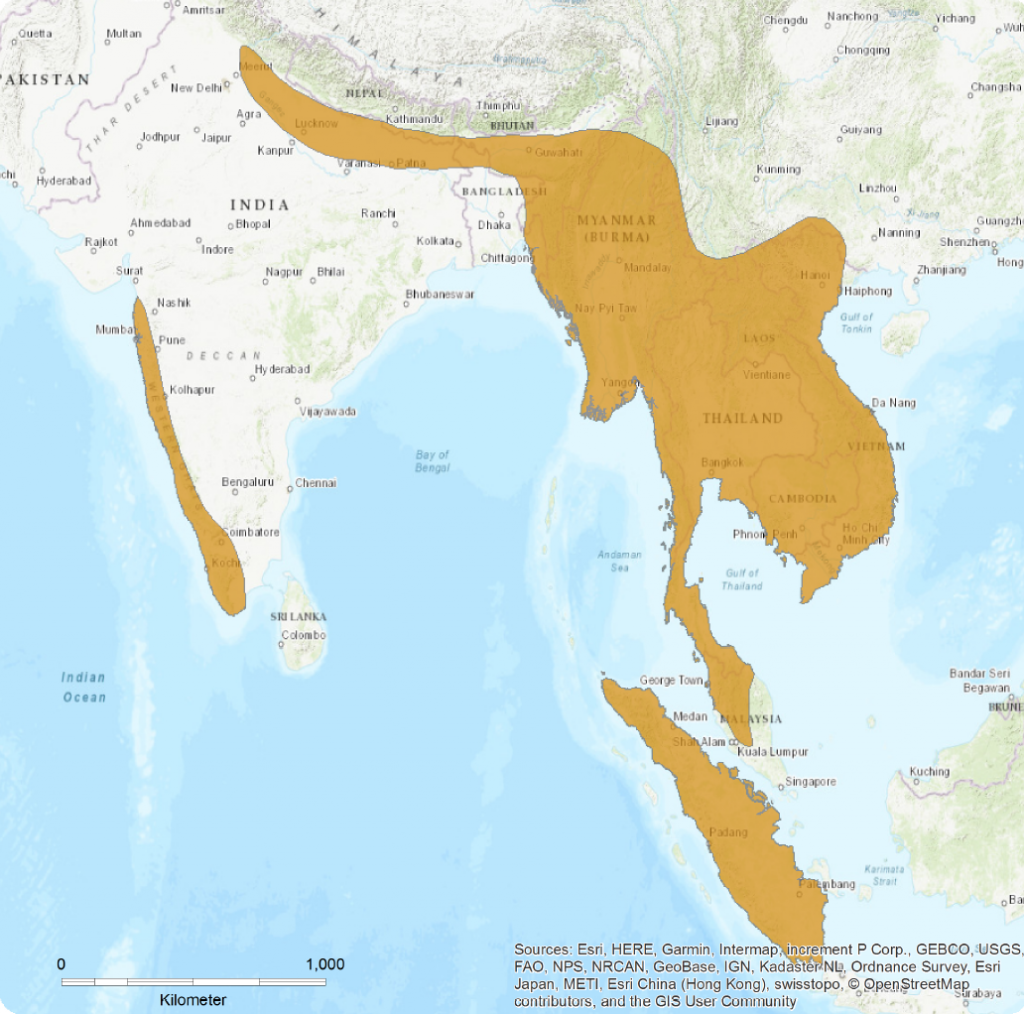
This is a species that is sensitive to habitat disturbance so logging and destruction of habitat leads to its its demise. Forestry in the region is being lost at the rate of about 26% over a period of 55 years which is equivalent to 3 hornbill generations. As such we can expect this to be the minimum rate of decline and the guess is that the species is probably declining faster at about 40% over the same period as a consequence of the added effects of hunting.
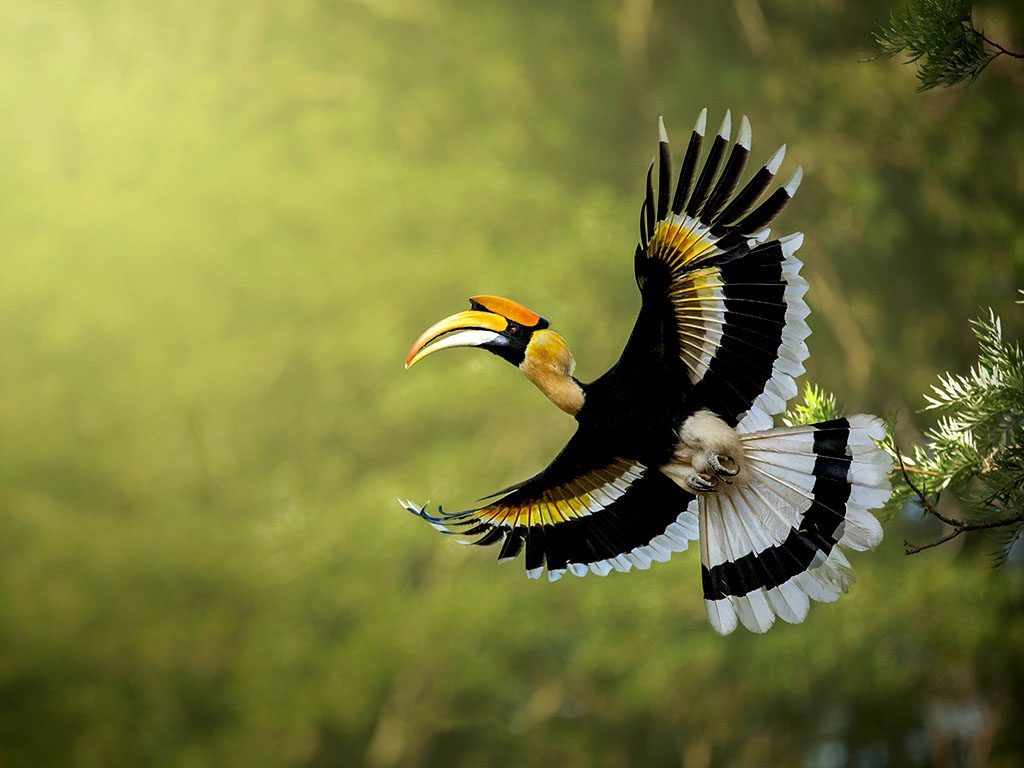
Giant Hornbill Needs
These birds need wet evergreen forests with a high density of large mature trees for nesting and sadly, it is these very trees that are targeted by loggers. Since these birds have exceptionally large home ranges, they require extensive tracts of undisturbed forest and are unable to persist in areas that have become fragmented through logging and human activities. In the species’ stronghold in north-eastern India, only 5% of the landscape offers suitable habitat as the human population encroaches into this habitat, remove the big trees, and fragment the forest.
What is more, as people move into the pristine forests, so they start hunting and since the behaviour of the birds is predictable and they regularly visit the same feeding sites, they are easily targeted by local hunters. In many areas the animal is mainly hunted by local people for food as well as for the casque and tail feathers, which have been used traditionally as an adornment. A major component of the bird’s diet is fruit, and they only breed when the fruit is abundant and available and so avoid the monsoon seasons between July and January.
Two fruiting species are particularly important: the fig trees and the berries produced by the peacock chaste tree since these are lipid-rich fruit that help the growth of the chicks

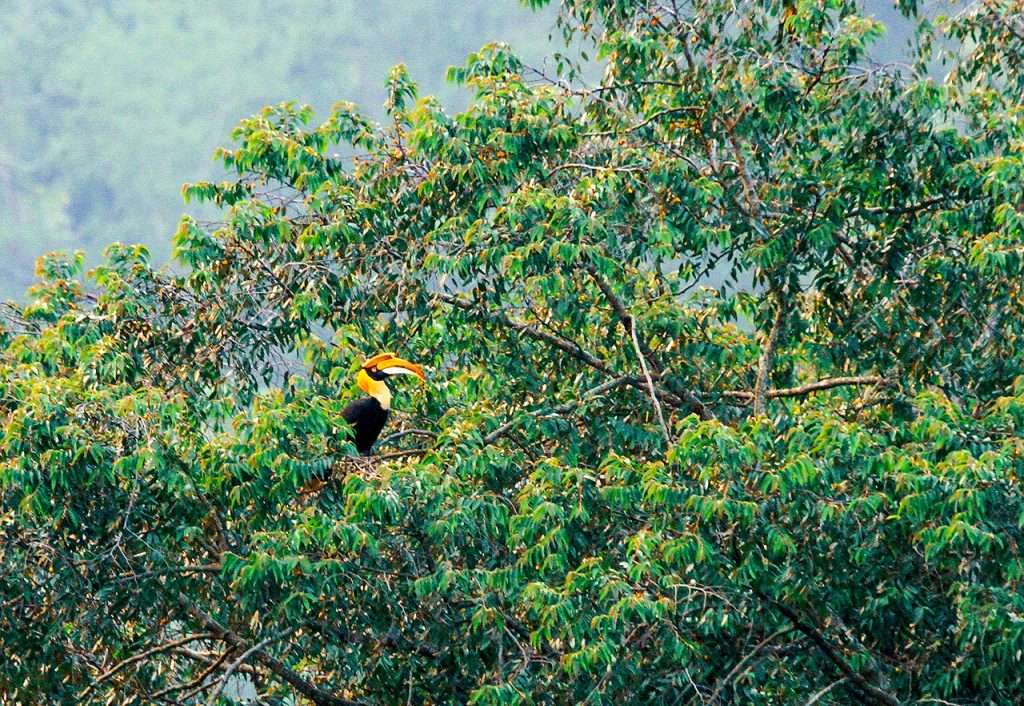
Conservation actions
The primary need for the conservation of this beautiful bird is of course to reduce habitat destruction and encourage the maturation of large sweeps of forestry. They need extensive areas of evergreen wetland forest, so we need to re-establish fragmented forests, protect the old and mature trees and work out incentives between private and public landowners to build a safeguarded population. None of this is easy but there is an increasing awareness that the loss of natural forests is bad for the well-being and health of humans so some countries, like Australia, are starting large scale reforestation programs.
At the local scale, the great conservation successes have involved the indigenous people that share the forest with the hornbills. A number of places including Thailand and northeast India now run “Hornbill Nest Adoption Programs” through the Nature Conservation Program and encourage people to adopt wild hornbill nests and provide funds to pay for nest guardians who protect and monitor nest sites. In some areas they have even been installing artificial nest boxes with some success.

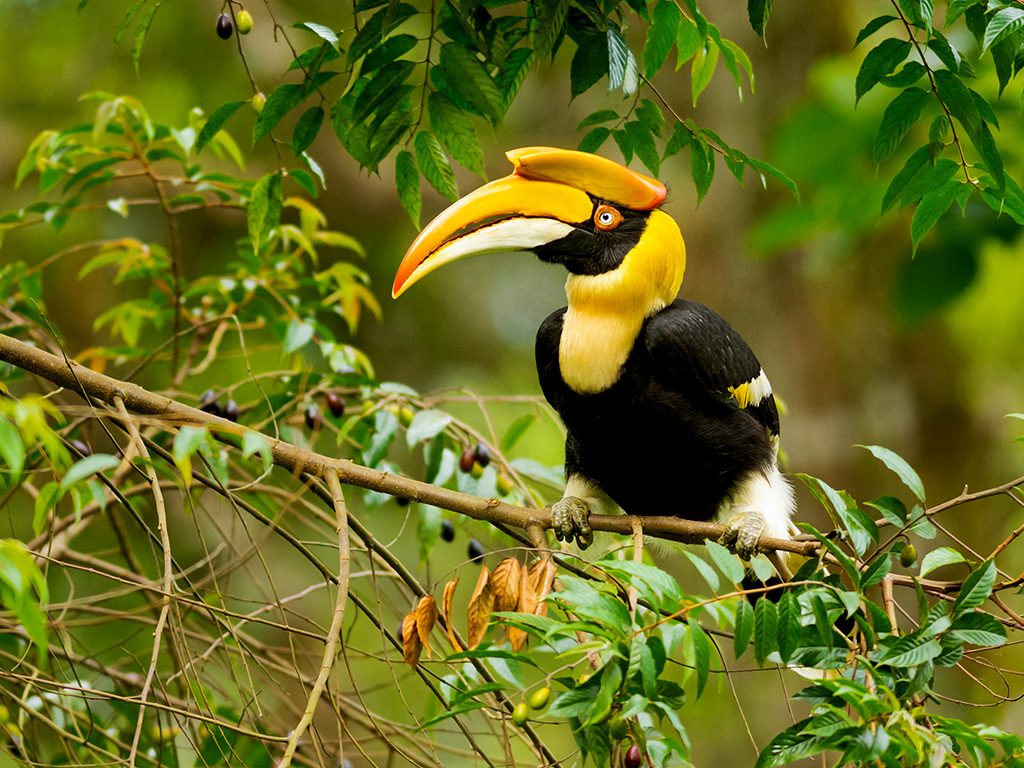
This has gone further in the Western Ghats where conservationists and forest department have started working with the local Kadar community. Back in 2002 there was a move to build another huge hydroelectric scheme known as the Athirappilly hydroelectric dam in the Anamalai hills that would have destroyed a large area of the Vazhachal forest, rich in hornbills and would have affected about 2000 Kadar people who rely on the forest. At this point in history, the Kadar people were blamed for the falling hornbill population since traditionally they would hunt the bird for its meat and casque, even though it was listed in schedule 1 of the Indian Wildlife Protection Act. Indeed, there were many people who were saddened to see the state bird of Kerala being lost.


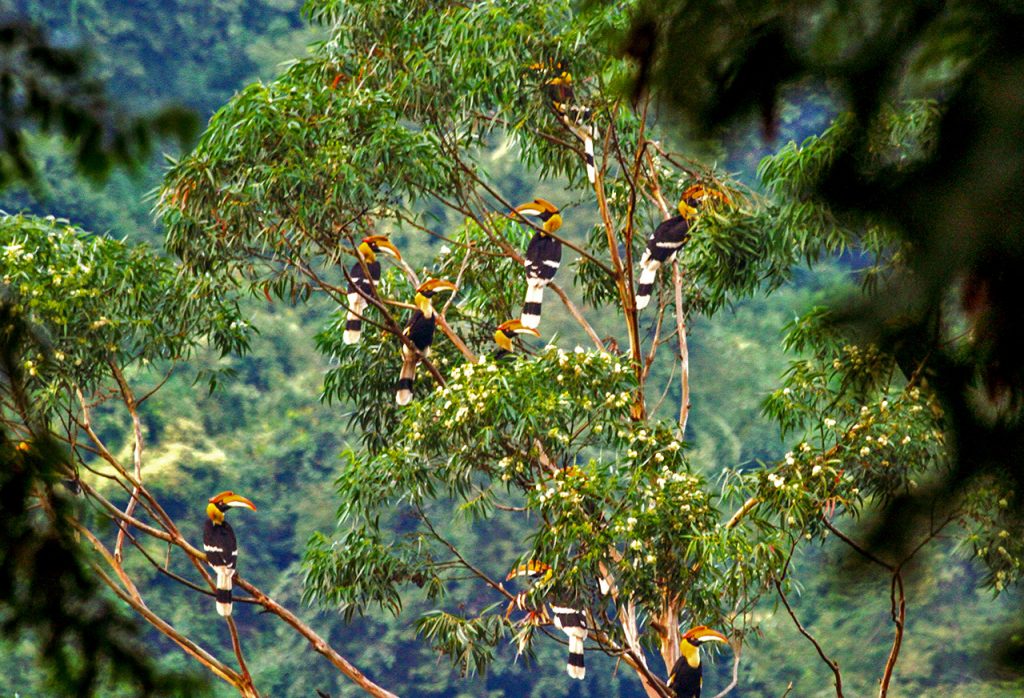
The real conservation insight emerged when it was appreciated that the Kadar people were an integral part of the ecosystem and saving their cultural heritage was entwined with saving the forests and the hornbills. What started out as a pure conservation project, slowly evolved into a political movement that embraced the local people and it was the Forest Rights Act, that aims to help the tribal rights, that eventually helped prevent the construction of the dam. Together they saved the forest from the development and this concerted action helped both the hornbills and the traditional livelihoods of the local people, so they could continue to fish and collect honey and dammar (a tree-based resin).
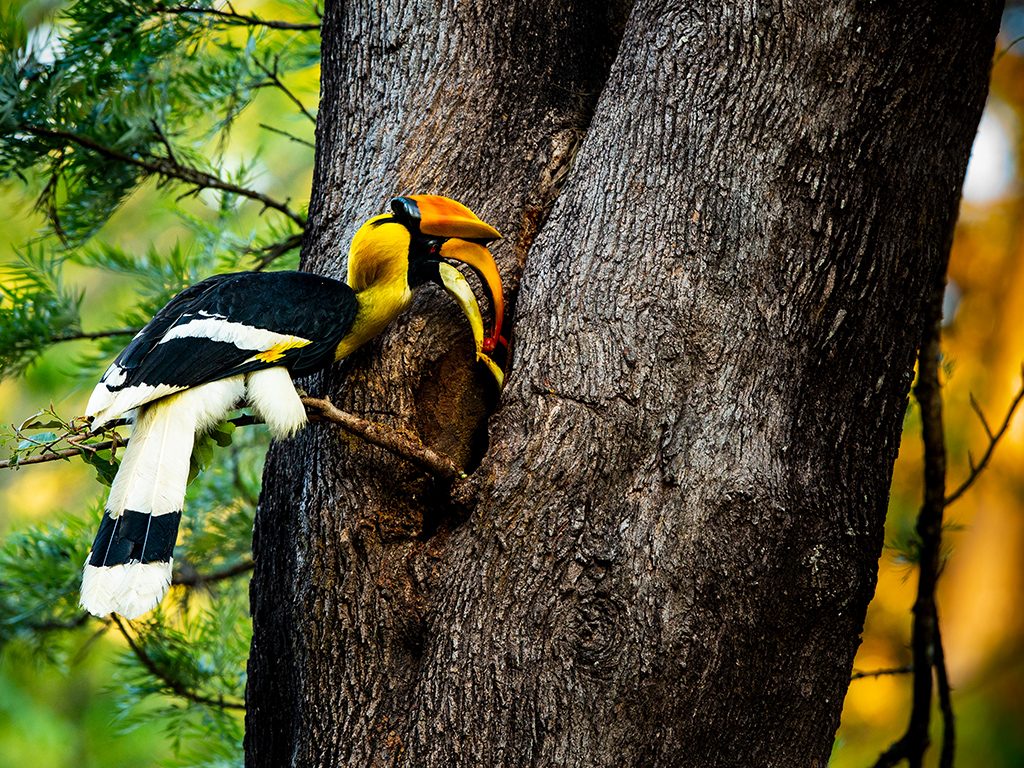
Out of this consortium has emerged a group of 72 Kadar youth who have become involved in hornbill protection. They have been working to safeguard more than 100 hornbill nests by preventing poaching, illegal felling of trees and engaging in wildfire prevention that can start in local plantations. The tribal youngsters are trained in monitoring and conservation of hornbills, but this is now expanding into the protection of the rainforest ecosystem. Admittedly, this is just a start and a start on a small scale but a positive move in the right direction that brings young people into active conservation
Figure 1: Distribution of Great Hornbill (Buceros bicornis), complied by Bird Life International and The Handbook of the Birds of the world (2016).
